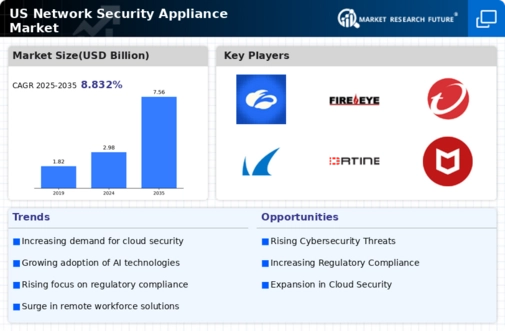Growing Remote Work Culture
The shift towards remote work has transformed the landscape of the network security-appliance market. As organizations adapt to this new normal, the need for secure remote access solutions has become paramount. Employees accessing corporate networks from various locations introduce vulnerabilities that necessitate the deployment of advanced security appliances. The market is likely to expand as companies seek to protect sensitive data and maintain operational continuity. Research indicates that 70% of organizations plan to adopt a hybrid work model, further emphasizing the need for robust security measures. This evolving work culture is expected to drive innovation and investment in the network security-appliance market.
Rising Cyber Threats and Attacks
The network security-appliance market is experiencing heightened demand due to the increasing frequency and sophistication of cyber threats. In recent years, the number of reported cyber incidents has surged, with a notable rise in ransomware attacks and data breaches. This alarming trend compels organizations to invest in robust security appliances to safeguard their networks. According to estimates, the cost of cybercrime in the US is projected to reach $6 trillion annually by 2021, indicating a pressing need for effective security solutions. As businesses recognize the potential financial and reputational damage from cyber threats, the network security-appliance market is likely to see sustained growth as companies prioritize their cybersecurity infrastructure.
Increased Investment in IT Security Budgets
The network security-appliance market is witnessing a surge in investment as organizations allocate larger portions of their IT budgets to security initiatives. This trend reflects a growing recognition of the importance of cybersecurity in protecting critical assets. According to recent surveys, nearly 60% of organizations plan to increase their IT security budgets in the coming years. This heightened investment is likely to translate into increased demand for advanced security appliances that can effectively mitigate risks. As businesses prioritize cybersecurity, the network security-appliance market is expected to experience robust growth, driven by the need for comprehensive security solutions.
Regulatory Pressures and Compliance Requirements
The network security-appliance market is significantly influenced by the increasing regulatory pressures faced by organizations. Compliance with various regulations, such as the Health Insurance Portability and Accountability Act (HIPAA) and the General Data Protection Regulation (GDPR), necessitates the implementation of stringent security measures. Organizations are compelled to adopt advanced security appliances to ensure compliance and avoid hefty fines. The market is projected to grow as businesses invest in solutions that not only meet regulatory requirements but also enhance their overall security posture. The financial implications of non-compliance can be severe, with penalties reaching millions of dollars, thereby driving the demand for effective network security appliances.
Technological Advancements in Security Solutions
The network security-appliance market is benefiting from rapid technological advancements that enhance the effectiveness of security solutions. Innovations such as artificial intelligence, machine learning, and automation are being integrated into security appliances, enabling organizations to detect and respond to threats more efficiently. These advancements not only improve threat detection rates but also reduce response times, making security measures more proactive. The market is projected to grow as businesses increasingly adopt these cutting-edge technologies to bolster their defenses. As organizations seek to stay ahead of evolving threats, the demand for advanced network security appliances is likely to rise, driving market expansion.























Leave a Comment